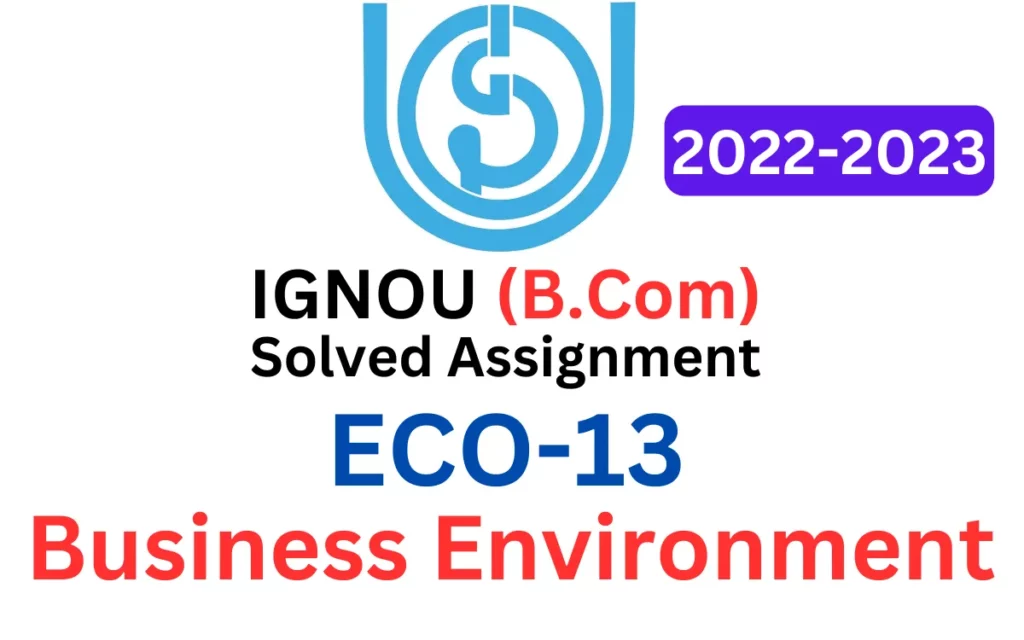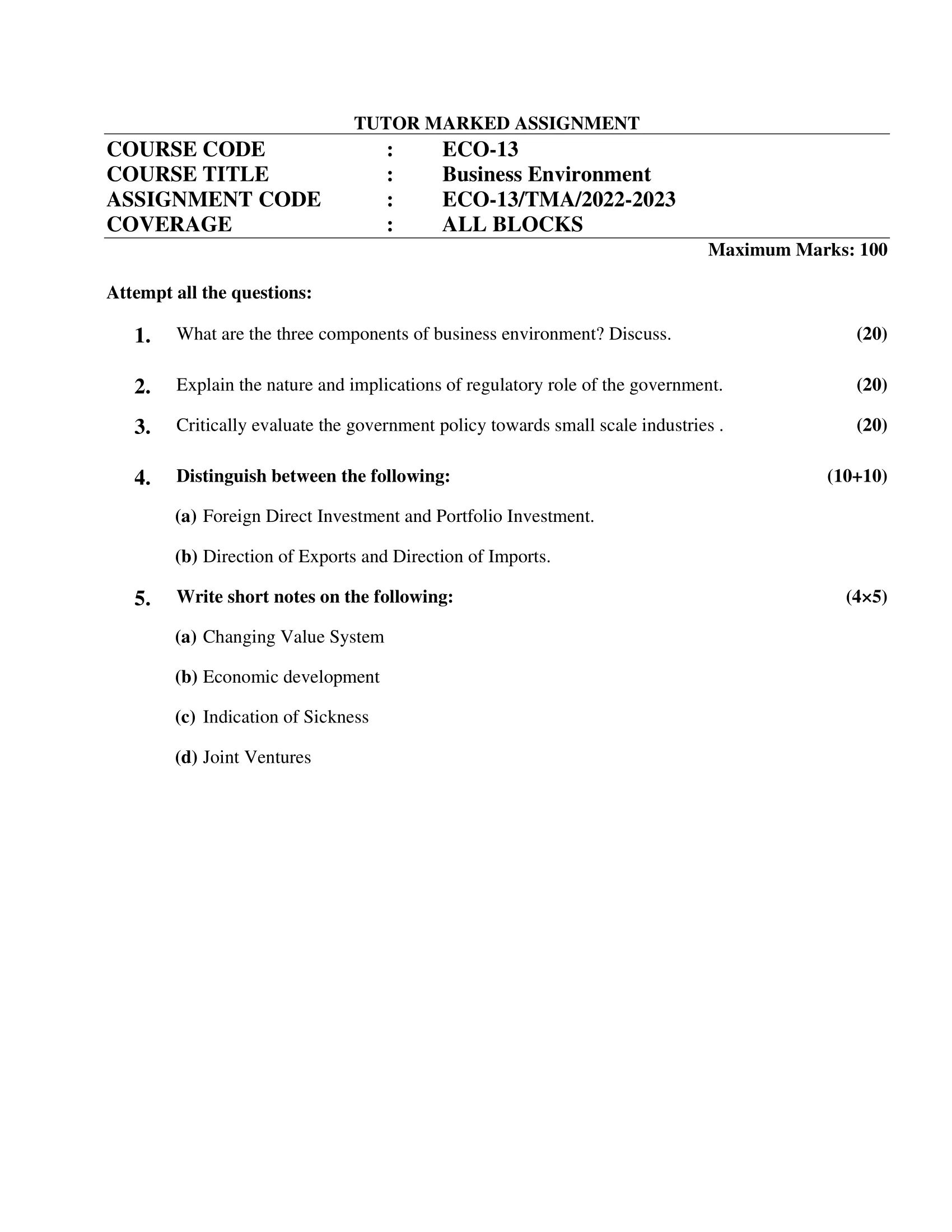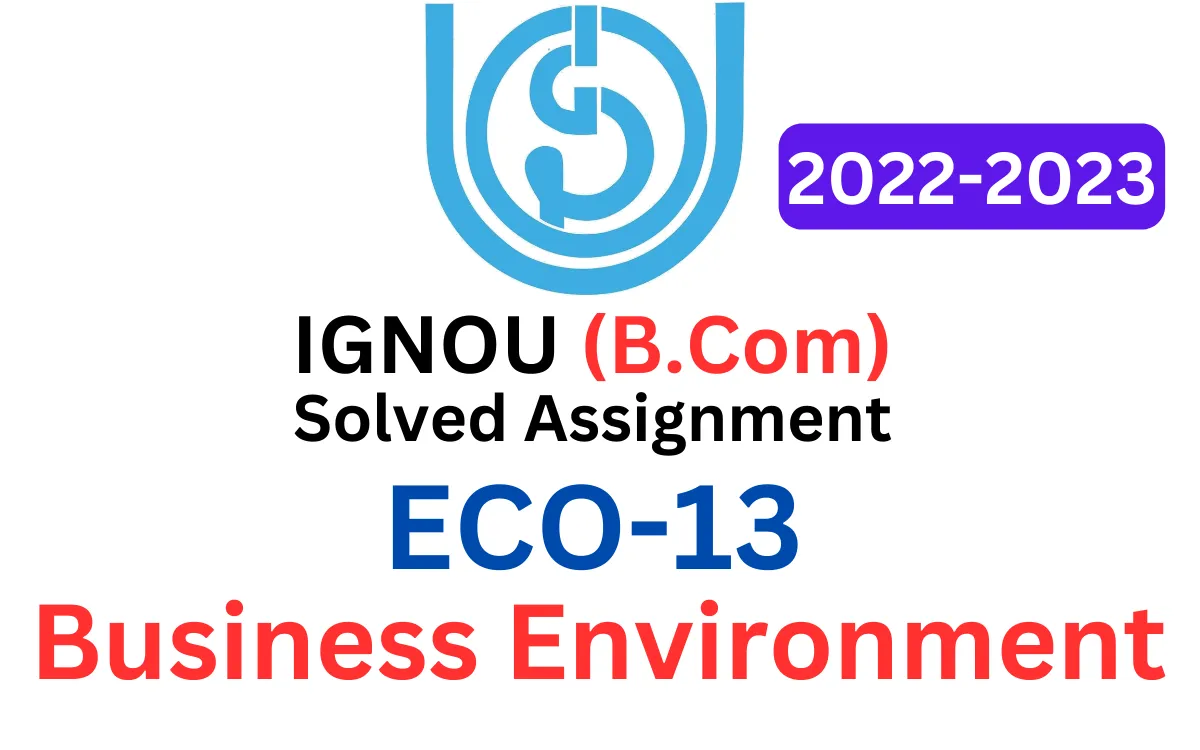
| Title | ECO-13: IGNOU B.Com Solved Assignment 2022-2023 |
| University | IGNOU |
| Degree | Bachelor Degree Programme |
| Course Code | ECO-13 |
| Course Name | Business Environment |
| Programme Name | B.Com |
| Programme Code | BDP |
| Total Marks | 100 |
| Year | 2022-2023 |
| Language | English |
| Assignment Code | ECO-13/TMA/2022-2023 |
| Assignment PDF | Click Here |
| Last Date for Submission of Assignment: | For June Examination: 31st April For December Examination: 30th September |

1. What are the three components of business environment? Discuss.
Ans: The business environment refers to the various factors that affect the operations and performance of a business. These factors can be classified into three main components:
- Internal Environment: The internal environment of a business consists of factors that are within the control of the organization. These include the organization’s vision, mission, goals, values, culture, resources, structure, leadership, and employees. The internal environment is shaped by the decisions and actions of the management and employees, and it plays a critical role in determining the success of a business.
- External Environment: The external environment of a business consists of factors that are outside the control of the organization. These include the economic, social, technological, legal, political, and environmental factors that affect the business. The external environment can have a significant impact on the performance of a business, and managers must monitor and adapt to these factors to ensure the organization’s success.
- Competitive Environment: The competitive environment of a business consists of the other businesses and organizations that operate in the same market or industry. These competitors can have a significant impact on the success of a business, as they may offer similar products or services and compete for the same customers. Managers must analyze the competitive environment and develop strategies to differentiate their business from competitors and gain a competitive advantage.
2. Explain the nature and implications of regulatory role of the government.
Ans: The regulatory role of the government refers to the use of laws, policies, and regulations to control or guide the behavior of individuals and organizations in a particular sector or industry. This role is important to ensure that businesses operate in a manner that protects the interests of the public and promotes fair competition.
The nature of the regulatory role of the government can vary depending on the specific industry or sector being regulated. For example, in the financial sector, the government may regulate the amount of capital that banks must hold to ensure their financial stability and protect consumers’ deposits. In the healthcare sector, the government may regulate the safety and efficacy of drugs and medical devices to protect patients’ health.
There are several implications of the regulatory role of the government. One of the primary implications is that it can increase the cost of doing business for companies. Compliance with regulations can require significant resources, including time, money, and personnel. This can make it more difficult for smaller businesses to compete with larger firms that have more resources to devote to regulatory compliance.
However, the regulatory role of the government can also have several benefits. It can help protect consumers from harm by ensuring that products and services are safe and effective. It can also promote fair competition by preventing companies from engaging in anti-competitive behavior such as price-fixing or monopolizing markets. Additionally, regulation can help promote social and environmental goals such as reducing pollution or promoting renewable energy.
3. Critically evaluate the government policy towards small scale industries.
Ans: Government policy towards small scale industries can have a significant impact on the success and growth of these businesses. In general, small scale industries are seen as an important driver of economic growth and job creation, particularly in developing countries where they often make up a significant portion of the economy.
There are several ways in which the government can support small scale industries. These include providing access to financing, creating favorable tax policies, reducing bureaucratic hurdles, and providing training and technical support to entrepreneurs. However, the effectiveness of government policies towards small scale industries can vary depending on a range of factors, including the specific policies implemented, the local business environment, and the needs of the small scale industry in question.
One potential criticism of government policy towards small scale industries is that it can be too fragmented or inconsistent. For example, there may be multiple government agencies or programs providing support to small businesses, but they may not be coordinated effectively or may have conflicting priorities. This can make it difficult for small businesses to navigate the system and access the support they need.
Another potential criticism is that government policies may not be targeted effectively towards the needs of small scale industries. For example, policies designed to promote entrepreneurship may not be effective if the local business environment is not conducive to small business growth. Additionally, policies that provide financing or technical support may not be helpful if small businesses do not have access to the resources they need to take advantage of these opportunities.
4. Distinguish between the following:
(a) Foreign Direct Investment and Portfolio Investment.
Ans: Foreign Direct Investment (FDI) and Portfolio Investment (PI) are two different forms of investment that involve investing in foreign countries. The main differences between FDI and PI are as follows:
- Control: FDI involves the ownership and control of a foreign company, while PI does not. In FDI, a company establishes a new operation or acquires an existing company in a foreign country, and manages it as a subsidiary. In contrast, PI involves the purchase of stocks, bonds, or other securities of a foreign company, but does not give the investor control over the company’s operations.
- Purpose: FDI is usually done with the long-term goal of establishing a permanent presence in a foreign market and expanding the company’s operations and market share. On the other hand, PI is done with the intention of generating short-term profits from fluctuations in the stock or bond prices.
- Risk: FDI involves a higher level of risk than PI because it requires a substantial investment of capital and resources in a foreign market, and the success of the investment depends on the company’s ability to effectively manage and compete in that market. PI, on the other hand, is a relatively low-risk investment because it involves only the purchase of securities and does not require a significant investment in the foreign market.
- Returns: FDI typically generates returns from the profits of the subsidiary, while PI generates returns from dividends and capital gains from the sale of securities.
(b) Direction of Exports and Direction of Imports.
Ans: The direction of exports and the direction of imports refer to the countries or regions from which a country sells goods and services to and the countries or regions from which it buys goods and services from, respectively. The main differences between the two are as follows:
- Outward or Inward Orientation: The direction of exports is an outward-oriented measure, as it refers to the countries or regions that a country is selling its goods and services to. The direction of imports, on the other hand, is an inward-oriented measure, as it refers to the countries or regions from which a country is buying its goods and services.
- Trade Balance: The direction of exports and the direction of imports are both important in determining a country’s trade balance. If a country’s exports exceed its imports, it has a trade surplus. Conversely, if its imports exceed its exports, it has a trade deficit.
- Economic Growth: A country’s direction of exports and imports can also have an impact on its economic growth. Export-oriented economies tend to grow faster than those that rely more on domestic consumption, as exporting countries have access to larger markets, greater economies of scale, and more competitive pricing. Similarly, countries that import a wide range of goods and services can benefit from lower costs, increased competition, and improved quality of goods.
- Trade Policies: A country’s direction of exports and imports can also be influenced by its trade policies, such as tariffs, quotas, and other trade restrictions. These policies can affect the volume, direction, and composition of trade, as well as the overall trade balance.
5. Write short notes on the following:
(a) Changing Value System
Ans: A value system refers to a set of beliefs, attitudes, and ideals that an individual or a society holds about what is right or wrong, good or bad, and desirable or undesirable. A changing value system refers to the process of transformation in these beliefs, attitudes, and ideals, which can occur due to various social, cultural, economic, and technological factors.
One of the main drivers of a changing value system is the generational shift. As new generations grow up and take on different roles in society, they often bring with them new values and attitudes that can challenge or replace traditional ones. For example, younger generations may have different views on gender roles, environmental issues, and social justice, which can lead to changes in societal norms and expectations.
Technological advancements and globalization are also significant factors that contribute to a changing value system. The increasing interconnectedness of the world through the internet and social media has led to greater exposure to diverse cultures and perspectives, which can influence and shape individual and societal values.
Changing value systems can have both positive and negative impacts on individuals and society. On the positive side, changes in values can lead to greater acceptance and tolerance of diversity, improved social justice, and increased awareness of environmental issues. However, changes in values can also lead to conflicts and tensions between different groups and may result in the erosion of traditional cultural values and practices.
(b) Economic development
Ans: Economic development refers to the sustained and continuous improvement in the economic well-being and living standards of a society. It involves the increase in the production and consumption of goods and services, the reduction of poverty and unemployment, and the improvement of infrastructure and human capital.
Economic development is often measured by various indicators, including GDP (Gross Domestic Product) per capita, income distribution, and the Human Development Index (HDI). A country with high levels of economic development has a strong and diversified economy, a well-educated and healthy population, and a stable and efficient government that promotes economic growth.
Economic development can be achieved through various means, including investments in infrastructure, education, and healthcare, and the promotion of entrepreneurship and innovation. It also requires sound economic policies and institutions that foster a conducive business environment, encourage foreign investments, and promote sustainable development.
There are different stages of economic development, ranging from traditional economies to industrialized and post-industrial economies. The path of economic development may differ across countries and regions depending on their resource endowments, level of technological advancement, and institutional and policy frameworks.
Economic development has both positive and negative impacts on society and the environment. While economic development can create job opportunities and improve living standards, it can also lead to environmental degradation, social inequality, and cultural homogenization.
(c) Indication of Sickness
Ans: In the context of economics, the term “sickness” is often used to refer to the state of an economy that is performing poorly and is experiencing various economic problems. There are several indications that can suggest an economy is in a state of sickness. Some of the common indicators are:
- High Inflation: One of the signs of a sick economy is high inflation. Inflation refers to the rate at which the general price level of goods and services is increasing. When the inflation rate is high, it means that the purchasing power of money is decreasing, and the cost of living is going up. This can make it difficult for people to afford basic necessities, leading to social and economic problems.
- High Unemployment: Another sign of a sick economy is high unemployment. When the unemployment rate is high, it means that a significant number of people are unable to find jobs, leading to a decline in consumer spending and a decrease in economic growth.
- Slow Economic Growth: A sick economy may experience slow or negative economic growth, which is a situation where the Gross Domestic Product (GDP) is not increasing or is decreasing. Slow economic growth can result from various factors, including a decrease in investment, lack of innovation, and low productivity.
- Low Investment: A lack of investment can indicate a sick economy. When businesses and individuals are not investing, it can lead to low economic growth, lack of job creation, and low innovation.
- High Debt Levels: High levels of debt, whether it is public or private, can indicate a sick economy. High debt levels can lead to reduced investment, higher interest rates, and a lack of confidence in the economy.
(d) Joint Ventures
Ans: Joint venture refers to a business arrangement in which two or more parties come together to undertake a specific business project or venture. In a joint venture, the parties involved typically pool their resources, expertise, and capital to achieve a common goal, which could be a new product, service, or project. The joint venture can be formed between two or more companies, individuals, or even governments.
Joint ventures can take various forms, including equity joint ventures, contractual joint ventures, and cooperative joint ventures. In an equity joint venture, the parties involved contribute equity capital, and the joint venture company is formed as a separate legal entity. In a contractual joint venture, the parties sign a contract to work together for a specific project or purpose, without forming a separate legal entity. A cooperative joint venture involves the sharing of resources and expertise between parties to achieve a common goal, but without forming a separate legal entity.
Joint ventures have several benefits, including sharing of resources and risks, access to new markets and technologies, and access to specialized skills and expertise. By pooling resources, joint ventures can achieve economies of scale and reduce costs, and by sharing risks, they can minimize the financial exposure of individual parties.
However, joint ventures also have their disadvantages, including the potential for conflict and disagreements between parties, the risk of loss of control, and the difficulty in finding the right partner with complementary skills and expertise.
How to Download ECO-13 Solved Assignment?
You can download it from the www.edukar.in, they have a big database for all the IGNOU solved assignments.
Is the ECO-13 Solved Assignment Free?
Yes this is absolutely free to download the solved assignment from www.edukar.in
What is the last submission date for ECO-13 Solved Assignment?
For June Examination: 31st April, For December Examination: 30th October




